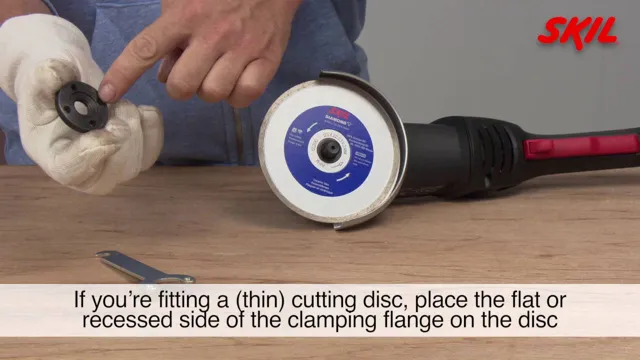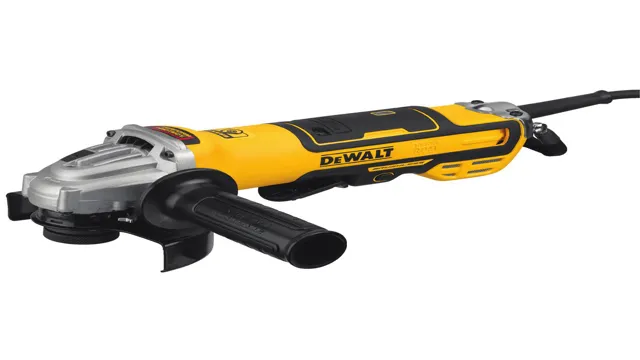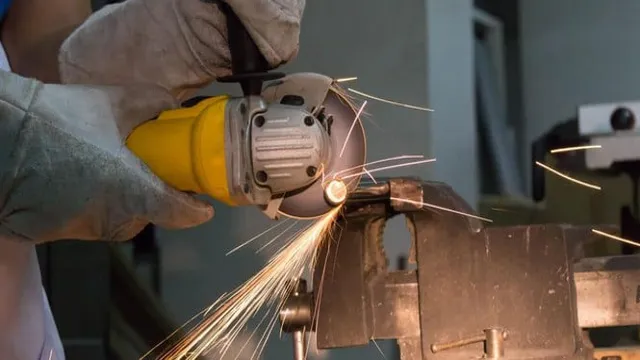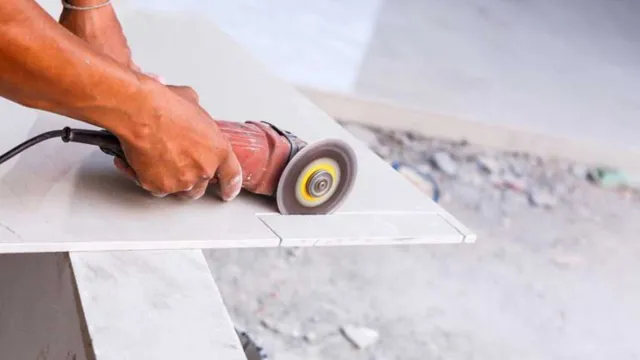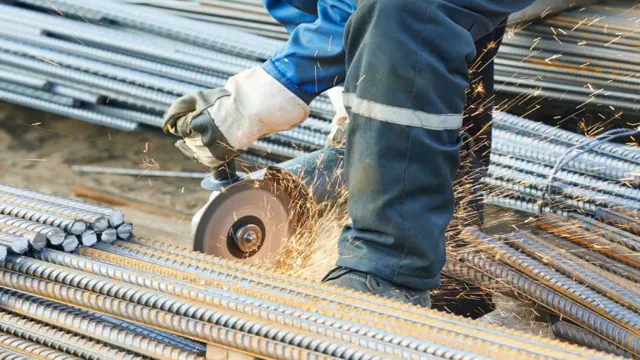Can an Angle Grinder Cut Stone? Tips and Tricks for Cutting Stones with Angle Grinders

Do you have a DIY project that involves cutting stone? Are you wondering what the best tool for the job is? Look no further than an angle grinder! Angle grinders are versatile tools used for cutting metal, tile, and even stone. With the right blade and techniques, an angle grinder can make quick work of stone cutting, saving you time and effort. But is it the right tool for every stone-cutting job? In this blog, we’ll explore the ins and outs of using an angle grinder for stone cutting and give you some tips to ensure success.
So grab your safety gear and let’s get started!
Understanding Angle Grinders and Stones
Yes, an angle grinder can cut stone. It’s a versatile tool that can be used for different types of cutting tasks, including cutting and shaping stones. However, to cut stone using an angle grinder, you need to use the right type of blade.
The blade should be designed specifically for cutting stone to ensure precision, safety, and efficiency. Diamond-tipped blades are a popular choice for cutting stone as they are strong, durable, and can cut through the toughest material. Additionally, when cutting stone with an angle grinder, it’s important to take safety precautions such as wearing protective gear like gloves, safety glasses, and a dust mask.
The use of water is also crucial as it reduces dust, cools down the blade, and helps to prolong its lifespan. Overall, with the right blade and safety precautions, an angle grinder can be used to cut different types of stone, making it a valuable tool for DIY enthusiasts, landscapers, and renovation professionals.
What is an Angle Grinder?
An angle grinder is a versatile tool used for cutting, grinding, and polishing different materials such as metal, tile, and concrete. It consists of a motor, a handle, and a rotating disc wheel made of abrasive material. The motor powers the disc to spin at high speed, allowing it to work through heavy-duty tasks.
Angle grinders are available in various sizes and styles, with the most common ones having disc sizes of 5, 5, and 7 inches. However, you must use the correct type and size of the disc for the task at hand to avoid damaging the tool or causing harm to yourself.
Different types of discs have varying grit sizes and materials, depending on the task they are designed for. Whether you need to grind down rust on your car or polish a concrete surface, an angle grinder is a useful tool to tackle various DIY and professional tasks.
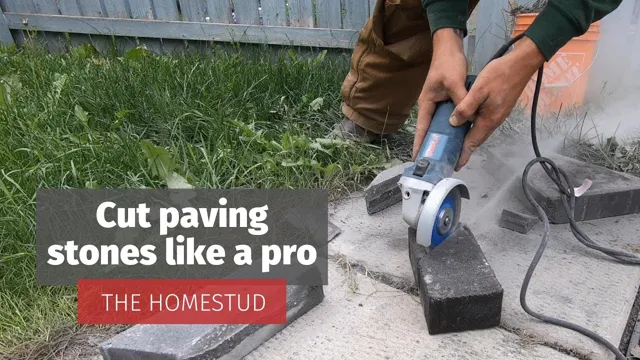
What are Stones?
Stones are hard, solid, naturally occurring materials that have been used by humans for thousands of years. They come in a variety of shapes, sizes, and colors, and can be used for a wide array of purposes. When it comes to the world of power tools, stones are often used with angle grinders.
Angle grinders are handheld power tools that use discs or stones to cut, grind, or polish materials such as metal, wood, and stone. Stones used with angle grinders typically come in two main varieties: grinding stones and cutting stones. Grinding stones are used for grinding and shaping hard materials, while cutting stones are used for cutting through tough materials such as metal and concrete.
It’s important to choose the right stone for the job at hand and to always use appropriate safety gear when operating an angle grinder.
How Do Angle Grinders Cut?
Angle grinders are powerful tools that are commonly used to cut and grind materials. Understanding how angle grinders work can help you get the most out of these tools and ensure that you use them safely. At the heart of an angle grinder is a motor that drives a rotating disc or wheel.
This disc or wheel is fitted with abrasive material, such as diamond or aluminum oxide, that grinds or cuts through the object being worked on. When the grinder is turned on, the disc spins rapidly, providing a powerful cutting or grinding action. While angle grinders can be incredibly useful, they are also potentially dangerous if not used properly.
It’s important to wear protective gear, such as eye and ear protection, when using an angle grinder, and to follow best practices for safe use. By understanding how angle grinders work, you can get the job done effectively and safely.
Factors to Consider When Cutting Stone
When it comes to cutting stone, an angle grinder may be able to get the job done, but certain factors must be considered. One important factor is the type of stone you’ll be cutting. Soft stones like limestone or sandstone can be cut with relatively low grit discs, while harder stones like granite or marble require higher grit discs and more power.
Additionally, the thickness of the stone also plays a role. Thicker stones will require more passes with the angle grinder and may cause the tool to overheat if not used properly. Proper safety equipment such as goggles and gloves should also be worn.
Overall, while an angle grinder can cut stone, it’s important to carefully consider the type and thickness of the stone as well as safety measures to ensure success and avoid accidents.
Type of Stone
When it comes to cutting stone, one of the most important factors to consider is the type of stone being used. Different types of stones require different cutting methods and tools. For example, softer stones like limestone can be cut with a handsaw, while harder stones like granite may require a specialized diamond-tipped saw.
The type of stone also affects the shape and size of the cuts that can be made. Some stones are more brittle and may be prone to cracking, while others are denser and more uniform, allowing for precision cuts. Additionally, the type of stone can also impact the overall appearance of the finished product, with some stones showcasing unique patterns or textures that should be accounted for during the cutting process.
To ensure the best results, it’s important to work with a professional stone cutter who has experience working with different types of stone and can provide expert guidance on the best cutting techniques to use.
Size and Thickness of Stone
When it comes to cutting stone, one of the most important factors to consider is the size and thickness of the material. The larger and thicker the stone, the more challenging it can be to cut. It’s important to use the right tools and techniques to ensure that the stone is cut accurately and without damage.
Professionals typically use diamond blades or wire saws to cut through thicker stones, while smaller stones can be cut with handheld tools such as chisels or saws. It’s also important to consider the type of stone being cut, as some materials are harder and more brittle than others. Granite, for example, is a very hard stone that requires a different approach than softer materials like limestone.
When cutting stone, precision is key, and it’s important to take the time to measure and mark the stone carefully before making any cuts. By paying careful attention to the size and thickness of the stone, as well as the type of material being cut, it’s possible to achieve the desired results with minimal waste or damage.
Type of Angle Grinder Blade
When it comes to cutting stone with an angle grinder, the type of blade you use is crucial in achieving the desired result. The first factor to consider is the type of blade. There are diamond blades and abrasive blades.
Diamond blades are a better option for cutting harder stone materials such as granite, marble, and limestone. On the other hand, abrasive blades are ideal for softer stones like soapstone and limestone. Other factors to consider include the size of the blade and the amount of grit on the blade.
The size of the blade will depend on the size of the stone you are cutting, while the amount of grit will determine how smooth the cut is. It is also important to choose a blade with a suitable arbor size for your angle grinder. When choosing the blade type, be sure to consider the thickness and density of the stone you are cutting.
Remember to always use safety gear like gloves, eye protection, and a dust mask when cutting stone with an angle grinder.
Safety Measures to Take When Cutting Stone
Yes, an angle grinder can cut stone, but it’s important to take certain safety measures to avoid accidents and injuries. First, wear appropriate personal protective equipment, such as safety goggles, ear plugs, gloves, and a dust mask. Stone cutting can produce a lot of dust, so it’s essential to keep the area well-ventilated and use a dust extraction system if possible.
Additionally, make sure the stone is securely clamped before cutting to prevent it from shifting or moving while you work. Use the correct blade for the type of stone you’re cutting, and avoid using a blade that’s damaged or worn out. Finally, take frequent breaks to rest your hands and arms and avoid fatigue, which can impair your control and judgment.
With these precautions in mind, an angle grinder can be an effective tool for cutting stone with precision and safety.
Wear Protective Gear
cutting stone, safety measures, protective gear When it comes to cutting stone, safety should always be your top priority. The process of cutting stone can be dangerous, as it involves sharp tools and heavy machinery that can cause serious harm if not handled with care. That’s why it’s essential to take the necessary safety measures, one of which is wearing protective gear.
Protective gear includes items such as gloves, safety glasses, and face shields, all of which are designed to protect you from flying debris and other potential hazards. By wearing the proper protective gear, you can not only reduce your risk of injury but also increase your confidence and control while cutting. Gloves can provide a better grip on your tools, while safety glasses can protect your eyes from dust and debris.
Face shields are particularly helpful when using high-powered machines, as they can shield your entire face and neck from flying debris. Remember, protective gear is only effective when worn correctly. Be sure to choose gear that fits properly and is appropriate for the job at hand.
Also, don’t forget to wear appropriate clothing and footwear, as loose or baggy clothes can easily get caught in machinery. In short, wearing protective gear is one of the most important safety measures you can take when cutting stone. So, be sure to gear up before getting down to work!
Secure the Stone
If you’re working with stone, safety should be a top priority. Whether you’re a professional or a DIY enthusiast, there are a number of safety measures you should take to reduce the risk of injury. First and foremost, you’ll need to wear the appropriate Personal Protective Equipment (PPE).
This means sturdy gloves, eye protection, earplugs, and a respiratory mask to protect your lungs from dust and debris. Additionally, you’ll want to secure the stone you’re working with to prevent it from shifting or slipping during the cutting process. This can be done with clamps or a specialized tool called a stone holder.
Taking these precautions can help ensure that your stone-cutting experience is safe and successful, keeping you and those around you protected from harm.
Use a Dust Mask
Cutting stone can be a dangerous task, and it’s crucial to take safety measures to prevent injury. One of the most important precautions to take is to use a dust mask. When you’re cutting stone, it releases fine particles of dust into the air that can get into your lungs.
Inhaling this dust can cause respiratory problems and even long-term health issues. Wearing a dust mask helps protect your lungs and ensures that you’re breathing clean air. Additionally, it’s important to make sure that the dust mask you use is rated for the type of stone you’re cutting.
Some types of stone can release hazardous chemicals when cut, and you need a mask that can filter them out. Remember, taking proper safety measures is crucial when working with stone, and using a dust mask is just one way to protect yourself and your health.
Conclusion and Recommendations
In conclusion, there’s no need to be a rock scientist to answer the question “can an angle grinder cut stone?” The answer is a resounding yes! With the right blade and proper technique, an angle grinder can slice through stone like a hot knife through butter. So go ahead and unleash your inner Michelangelo, and start cutting those stones to create your own masterpiece. Just remember to wear protective gear and handle the machine with caution to avoid any unwanted accidents.
Happy cutting!”
FAQs
What is an angle grinder and how does it work for stone cutting?
An angle grinder is a handheld power tool that operates at high speed and is used for stone cutting through spinning discs or wheels.
What type of disc should be used to cut stone with an angle grinder?
A diamond-tipped cutting disc is recommended for cutting stone with an angle grinder.
What safety precautions should I take when using an angle grinder to cut stone?
Wear safety glasses, a dust mask, and heavy-duty work gloves. Securely fasten the stone to a stable surface before cutting and keep bystanders away from the work area.
What is the maximum depth of cut that an angle grinder can make in stone?
The maximum depth of cut that an angle grinder can make in stone depends on the blade diameter and the power of the tool. However, it is generally recommended to make several shallow cuts instead of a single deep cut.
Can an angle grinder be used to grind or shape stone in addition to cutting?
Yes, an angle grinder can be used for grinding or shaping stone in addition to cutting. It requires the use of different attachments and/or accessories.
What is the cost of a good quality angle grinder for cutting stone?
The cost of a good quality angle grinder for cutting stone varies depending on the brand, power, and features. It can range from $50 to $200 or more.
Can an angle grinder be used to cut other materials besides stone?
Yes, an angle grinder can be used to cut a variety of materials such as metal, tile, wood, concrete, and more. The appropriate cutting disc or wheel must be used for each specific material.


